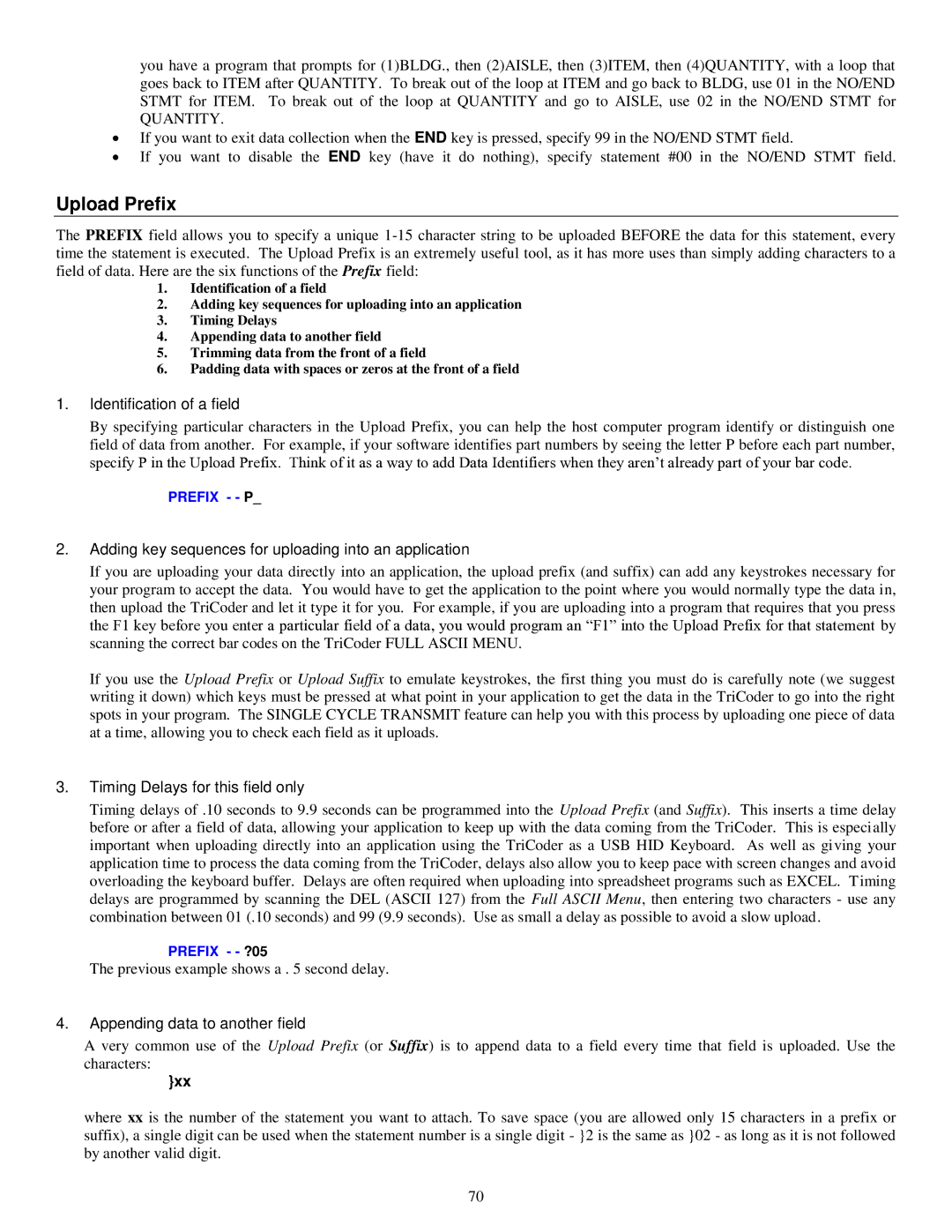you have a program that prompts for (1)BLDG., then (2)AISLE, then (3)ITEM, then (4)QUANTITY, with a loop that goes back to ITEM after QUANTITY. To break out of the loop at ITEM and go back to BLDG, use 01 in the NO/END STMT for ITEM. To break out of the loop at QUANTITY and go to AISLE, use 02 in the NO/END STMT for
QUANTITY.
∙If you want to exit data collection when the END key is pressed, specify 99 in the NO/END STMT field.
∙If you want to disable the END key (have it do nothing), specify statement #00 in the NO/END STMT field.
Upload Prefix
The PREFIX field allows you to specify a unique
1.Identification of a field
2.Adding key sequences for uploading into an application
3.Timing Delays
4.Appending data to another field
5.Trimming data from the front of a field
6.Padding data with spaces or zeros at the front of a field
1.Identification of a field
By specifying particular characters in the Upload Prefix, you can help the host computer program identify or distinguish one field of data from another. For example, if your software identifies part numbers by seeing the letter P before each part number, specify P in the Upload Prefix. Think of it as a way to add Data Identifiers when they aren‟t already part of your bar code.
PREFIX - - P_
2.Adding key sequences for uploading into an application
If you are uploading your data directly into an application, the upload prefix (and suffix) can add any keystrokes necessary for your program to accept the data. You would have to get the application to the point where you would normally type the data in, then upload the TriCoder and let it type it for you. For example, if you are uploading into a program that requires that you press the F1 key before you enter a particular field of a data, you would program an “F1” into the Upload Prefix for that statement by scanning the correct bar codes on the TriCoder FULL ASCII MENU.
If you use the Upload Prefix or Upload Suffix to emulate keystrokes, the first thing you must do is carefully note (we suggest writing it down) which keys must be pressed at what point in your application to get the data in the TriCoder to go into the right spots in your program. The SINGLE CYCLE TRANSMIT feature can help you with this process by uploading one piece of data at a time, allowing you to check each field as it uploads.
3.Timing Delays for this field only
Timing delays of .10 seconds to 9.9 seconds can be programmed into the Upload Prefix (and Suffix). This inserts a time delay before or after a field of data, allowing your application to keep up with the data coming from the TriCoder. This is especially important when uploading directly into an application using the TriCoder as a USB HID Keyboard. As well as giving your application time to process the data coming from the TriCoder, delays also allow you to keep pace with screen changes and avoid overloading the keyboard buffer. Delays are often required when uploading into spreadsheet programs such as EXCEL. Timing delays are programmed by scanning the DEL (ASCII 127) from the Full ASCII Menu, then entering two characters - use any combination between 01 (.10 seconds) and 99 (9.9 seconds). Use as small a delay as possible to avoid a slow upload.
PREFIX - - ?05
The previous example shows a . 5 second delay.
4.Appending data to another field
A very common use of the Upload Prefix (or Suffix) is to append data to a field every time that field is uploaded. Use the characters:
}xx
where xx is the number of the statement you want to attach. To save space (you are allowed only 15 characters in a prefix or suffix), a single digit can be used when the statement number is a single digit - }2 is the same as }02 - as long as it is not followed by another valid digit.
70
